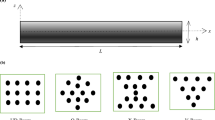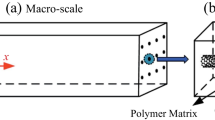Abstract
Purpose
A carbon nanotube-reinforced composite (CNTRC) beam resting on a Pasternak elastic foundation which consists of a Winkler spring and shear layer is investigated to obtain the bending, buckling, and free vibration responses using inverse hyperbolic shear deformation theory (IHSDT). The shear strain shape function is employed in this study to construct a nonlinear distribution of transverse shear stresses. The theory fulfills the traction-free boundary conditions on both the upper and lower surfaces of the beam, hence no shear correction factor is needed.
Methods
Hamilton’s principle is employed to derive the equation of motion and Navier’s solution technique is used to determining the closed-from solution for the CNTRC beam on the Pasternak foundation. To determine the material properties of CNTRC beams, the rule of mixture is used. In this study, various types of CNT reinforcement distribution are used such as uniform distribution (UD-Beam), X-Beam, O-Beam, and V-Beam.
Results
The deformation, stresses, critical buckling load, and natural frequencies of the simply supported CNTRC beam resting on the Pasternak elastic foundation are investigated using an analytical approach, that takes into account various length-to-thickness ratios, CNT volume fraction, CNT distribution, Winkler spring constant factor, and shear layer constant factor.
Conclusion
The present theory predicts the structural responses quite accurately compared to the available theories in the literature. Some new results are also included for the benchmark solutions for the new research.












Similar content being viewed by others
Data Availability
The authors can confirm that all relevant data are included in this article.
References
Iijima S (1991) Helical microtubules of graphitic carbon. Nature 354(6348):56–58. https://doi.org/10.1038/354056a0
Khaniki HB, Ghayesh MH (2020) A review on the mechanics of carbon nanotube strengthened deformable structures. Eng Struct. https://doi.org/10.1016/J.ENGSTRUCT.2020.110711
Lau AKT, Hui D (2002) The revolutionary creation of new advanced materials—carbon nanotube composites. Compos B Eng 33:263–277. https://doi.org/10.1016/S1359-8368(02)00012-4
Thostenson ET, Ren Z, Chou TW (2001) Advances in the science and technology of carbon nanotubes and their composites: a review. Compos Sci Technol 61:1899–1912. https://doi.org/10.1016/S0266-3538(01)00094-X
Saito Y, Hamaguchi K, Hata K et al (1997) Conical beams from open nanotubes. Nature 389(6651):554–555. https://doi.org/10.1038/39221
Niu C, Sichel EK, Hoch R et al (1997) High power electrochemical capacitors based on carbon nanotube electrodes. Appl Phys Lett 70:1480–1482. https://doi.org/10.1063/1.118568
Vaccarini L, Goze C, Henrard L et al (2000) Mechanical and electronic properties of carbon and boron–nitride nanotubes. Carbon N Y 38:1681–1690. https://doi.org/10.1016/S0008-6223(99)00293-6
Lijima S, Aikawa Y, Baba K (1991) Growth of diamond particles in chemical vapor deposition. J Mater Res 6(7):1491–1497. https://doi.org/10.1557/JMR.1991.1491
Iijima S, Ichihashi T (1993) Single-shell carbon nanotubes of 1-nm diameter. Nature 363(6430):603–605. https://doi.org/10.1038/363603a0
Bethune DS, Klang CH, De Vries MS et al (1993) Cobalt-catalysed growth of carbon nanotubes with single-atomic-layer walls. Nature 363(6430):605–607. https://doi.org/10.1038/363605a0
Kelly BT (1981) Physics of graphite 477
Liew KM, Pan Z, Zhang L-W et al (2020) The recent progress of functionally graded CNT reinforced composites and structures. SCPMA 63:234601. https://doi.org/10.1007/S11433-019-1457-2
Liew KM, Pan ZZ, Zhang LW (2019) An overview of layerwise theories for composite laminates and structures: development, numerical implementation and application. Compos Struct 216:240–259. https://doi.org/10.1016/J.COMPSTRUCT.2019.02.074
Imani Yengejeh S, Kazemi SA, Öchsner A (2017) Carbon nanotubes as reinforcement in composites: a review of the analytical, numerical and experimental approaches. Comput Mater Sci 136:85–101. https://doi.org/10.1016/J.COMMATSCI.2017.04.023
Ajayan PM, Stephan O, Colliex C, Trauth D (1994) Aligned carbon nanotube arrays formed by cutting a polymer resin–nanotube composite. Science 265:1212–1214. https://doi.org/10.1126/SCIENCE.265.5176.1212
Odegard GM, Gates TS, Wise KE et al (2003) Constitutive modeling of nanotube–reinforced polymer composites. Compos Sci Technol 63:1671–1687. https://doi.org/10.1016/S0266-3538(03)00063-0
Griebel M, Hamaekers J (2004) Molecular dynamics simulations of the elastic moduli of polymer–carbon nanotube composites. Comput Methods Appl Mech Eng 193:1773–1788. https://doi.org/10.1016/J.CMA.2003.12.025
Mokashi VV, Qian D, Liu Y (2007) A study on the tensile response and fracture in carbon nanotube-based composites using molecular mechanics. Compos Sci Technol 67:530–540. https://doi.org/10.1016/J.COMPSCITECH.2006.08.014
Lv T, Yao Y, Li N, Chen T (2016) Highly stretchable supercapacitors based on aligned carbon nanotube/molybdenum disulfide composites. Angew Chem Int Ed 55:9191–9195. https://doi.org/10.1002/ANIE.201603356
Yasuda S, Furuya A, Uchibori Y et al (2016) Iron–nitrogen-doped vertically aligned carbon nanotube electrocatalyst for the oxygen reduction reaction. Adv Funct Mater 26:738–744. https://doi.org/10.1002/ADFM.201503613
Xie H, Zhang R, Zhang Y et al (2016) Preloading catalysts in the reactor for repeated growth of horizontally aligned carbon nanotube arrays. Carbon N Y 98:157–161. https://doi.org/10.1016/J.CARBON.2015.11.001
Kang L, Zhang S, Li Q, Zhang J (2016) Growth of horizontal semiconducting SWNT arrays with density higher than 100 tubes/μm using ethanol/methane chemical vapor deposition. J Am Chem Soc 138:6727–6730. https://doi.org/10.1021/JACS.6B03527/ASSET/IMAGES/LARGE/JA-2016-03527H_0004.JPEG
Goh GL, Agarwala S, Yeong WY (2019) Directed and on-demand alignment of carbon nanotube: a review toward 3D printing of electronics. Adv Mater Interfaces 6:1801318. https://doi.org/10.1002/ADMI.201801318
Iakoubovskii K (2009) Techniques of aligning carbon nanotubes. Cent Eur J Phys 7:645–653. https://doi.org/10.2478/S11534-009-0072-2/MACHINEREADABLECITATION/RIS
Beigmoradi R, Samimi A, Mohebbi-Kalhori D (2018) Engineering of oriented carbon nanotubes in composite materials. Beilstein J Nanotechnol 9(41):415–435. https://doi.org/10.3762/BJNANO.9.41
Fisher FT, Bradshaw RD, Brinson LC (2002) Effects of nanotube waviness on the modulus of nanotube-reinforced polymers. Appl Phys Lett 80:4647. https://doi.org/10.1063/1.1487900
Xie S, Li W, Pan Z et al (2000) Mechanical and physical properties on carbon nanotube. J Phys Chem Solids 61:1153–1158. https://doi.org/10.1016/S0022-3697(99)00376-5
Ruoff RS, Lorents DC (1995) Mechanical and thermal properties of carbon nanotubes. Carbon N Y 33:925–930. https://doi.org/10.1016/0008-6223(95)00021-5
Britto PJ, Santhanam KSV, Rubio A et al (1999) Improved charge transfer at carbon nanotube electrodes. Adv Mater. https://doi.org/10.1002/(SICI)1521-4095(199902)11:2
Chen P, Wu X, Lin J (1979) Tan KL (1999) High H2 uptake by alkali-doped carbon nanotubes under ambient pressure and moderate temperatures. Science 285:91–93. https://doi.org/10.1126/SCIENCE.285.5424.91/ASSET/F5A52D4F-0F6B-42FC-AD53-1B1E13889218/ASSETS/GRAPHIC/SE2597628002.JPEG
Liu C, Fan YY, Liu M et al (1999) Hydrogen storage in single-walled carbon nanotubes at room temperature. Science 286:1127–1129. https://doi.org/10.1126/SCIENCE.286.5442.1127/ASSET/3583E91A-2068-4C36-AF1E-E45671795BB4/ASSETS/GRAPHIC/SE4397962003.JPEG
Samuel Ratna Kumar PS, Robinson Smart DS, John Alexis S (2017) Corrosion behaviour of aluminium metal matrix reinforced with multi-wall carbon nanotube. J Asian Ceram Soc 5:71–75. https://doi.org/10.1016/J.JASCER.2017.01.004
Shah KA, Tali BA (2016) Synthesis of carbon nanotubes by catalytic chemical vapour deposition: a review on carbon sources, catalysts and substrates. Mater Sci Semicond Process 41:67–82. https://doi.org/10.1016/J.MSSP.2015.08.013
Arora N, Sharma NN (2014) Arc discharge synthesis of carbon nanotubes: comprehensive review. Diam Relat Mater 50:135–150. https://doi.org/10.1016/J.DIAMOND.2014.10.001
Su Y, Zhang Y (2015) Carbon nanomaterials synthesized by arc discharge hot plasma. Carbon 83:90–99. https://doi.org/10.1016/J.CARBON.2014.11.023
Harris PJF (2007) Solid state growth mechanisms for carbon nanotubes. Carbon 45:229–239. https://doi.org/10.1016/J.CARBON.2006.09.023
Kingston CT, Simard B (2006) Recent advances in laser synthesis of single-walled carbon nanotubes. J Nanosci Nanotechnol 6:1225–1232. https://doi.org/10.1166/JNN.2006.310
Arepalli S (2004) Laser ablation process for single-walled carbon nanotube production. J Nanosci Nanotechnol 4:317–325. https://doi.org/10.1166/JNN.2004.072
Mubarak NM, Abdullah EC, Jayakumar NS, Sahu JN (2014) An overview on methods for the production of carbon nanotubes. J Ind Eng Chem 20:1186–1197. https://doi.org/10.1016/J.JIEC.2013.09.001
Jourdain V, Bichara C (2013) Current understanding of the growth of carbon nanotubes in catalytic chemical vapour deposition. Carbon N Y. https://doi.org/10.1016/j.carbon.2013.02.046ï
Koziol K, Boskovic BO, Yahya N (2011) Synthesis of carbon nanostructures by CVD method. Adv Struct Mater 5:23–49. https://doi.org/10.1007/8611_2010_12/COVER
Han Y, Elliott J (2007) Molecular dynamics simulations of the elastic properties of polymer/carbon nanotube composites. Comput Mater Sci 39:315–323. https://doi.org/10.1016/J.COMMATSCI.2006.06.011
Wattanasakulpong N, Ungbhakorn V (2013) Analytical solutions for bending, buckling and vibration responses of carbon nanotube-reinforced composite beams resting on elastic foundation. Comput Mater Sci 71:201–208. https://doi.org/10.1016/J.COMMATSCI.2013.01.028
Wuite J, Adali S (2005) Deflection and stress behaviour of nanocomposite reinforced beams using a multiscale analysis. Compos Struct 71:388–396. https://doi.org/10.1016/j.compstruct.2005.09.011
Shen HS, Xiang Y (2013) Nonlinear analysis of nanotube-reinforced composite beams resting on elastic foundations in thermal environments. Eng Struct 56:698–708. https://doi.org/10.1016/J.ENGSTRUCT.2013.06.002
Kumar P, Srinivas J (2017) Free vibration, bending and buckling of a FG-CNT reinforced composite beam: comparative analysis with hybrid laminated composite beam. Multidiscip Model Mater Struct 13:590–611. https://doi.org/10.1108/MMMS-05-2017-0032/FULL/PDF
Yas MH, Samadi N (2012) Free vibrations and buckling analysis of carbon nanotube-reinforced composite Timoshenko beams on elastic foundation. Int J Press Vessels Pip 98:119–128. https://doi.org/10.1016/J.IJPVP.2012.07.012
Wu HL, Yang J, Kitipornchai S (2016) Imperfection sensitivity of postbuckling behaviour of functionally graded carbon nanotube-reinforced composite beams. Thin-Walled Struct 108:225–233. https://doi.org/10.1016/J.TWS.2016.08.024
Kiani Y (2016) Thermal postbuckling of temperature-dependent sandwich beams with carbon nanotube-reinforced face sheets. J Therm Stresses 39:1098–1110. https://doi.org/10.1080/01495739.2016.1192856
Mirzaei M, Kiani Y (2016) Nonlinear free vibration of temperature-dependent sandwich beams with carbon nanotube-reinforced face sheets. Acta Mech 227(7):1869–1884. https://doi.org/10.1007/S00707-016-1593-6
Singh SD, Sahoo R (2021) Static and free vibration analysis of functionally graded CNT reinforced sandwich plates using inverse hyperbolic shear deformation theory. J Strain Anal Eng Des 56:386–403. https://doi.org/10.1177/0309324720957568/ASSET/IMAGES/LARGE/10.1177_0309324720957568-FIG2.JPEG
Singh SD, Sahoo R (2020) Static and free vibration analysis of functionally graded CNT reinforced composite plates using trigonometric shear deformation theory. Structures 28:685–696. https://doi.org/10.1016/J.ISTRUC.2020.09.008
Singh SD, Sahoo R (2021) Analytical solution for static and free vibration analysis of functionally graded CNT-reinforced sandwich plates. Arch Appl Mech 91:3819–3834. https://doi.org/10.1007/S00419-021-01979-1/FIGURES/6
Xu H, Wang YQ (2022) Differential transformation method for free vibration analysis of rotating Timoshenko beams with elastic boundary conditions. Int J Appl Mech. https://doi.org/10.1142/S1758825122500466
Cui Y, Wang Y (2024) Effect of disk flexibility on nonlinear vibration characteristics of shaft-disk rotors. Acta Mech Sinica/Lixue Xuebao 40:1–15. https://doi.org/10.1007/S10409-023-23140-X/METRICS
Wang YQ, Xing WC, Wang J, Chai Q (2023) Theoretical and experimental studies on vibration characteristics of bolted joint multi-plate structures. Int J Mech Sci 252:108348. https://doi.org/10.1016/J.IJMECSCI.2023.108348
Xing WC, Wang J, Wang YQ (2024) An effective model for bolted flange joints and its application in vibrations of bolted flange joint multiple-plate structures: theory with experiment verification. Appl Math Model 126:482–505. https://doi.org/10.1016/J.APM.2023.11.013
Grover N, Maiti DK, Singh BN (2013) A new inverse hyperbolic shear deformation theory for static and buckling analysis of laminated composite and sandwich plates. Compos Struct 95:667–675. https://doi.org/10.1016/J.COMPSTRUCT.2012.08.012
Ke LL, Yang J, Kitipornchai S (2010) Nonlinear free vibration of functionally graded carbon nanotube-reinforced composite beams. Compos Struct 92:676–683. https://doi.org/10.1016/J.COMPSTRUCT.2009.09.024
Reddy JN (1984) A simple higher-order theory for laminated composite plates. J Appl Mech 51:745–752. https://doi.org/10.1115/1.3167719
Tagrara SH, Benachour A, Bouiadjra MB et al (2015) On bending, buckling and vibration responses of functionally graded carbon nanotube-reinforced composite beams. Steel Compos Struct 19:1259. https://doi.org/10.12989/SCS.2015.19.5.1259
Liew KM, Yang J, Kitipornchai S (2003) Postbuckling of piezoelectric FGM plates subject to thermo-electro-mechanical loading. Int J Solids Struct 40:3869–3892. https://doi.org/10.1016/S0020-7683(03)00096-9
Acknowledgements
The support of Science and Engineering Research Board (SERB), Department of Science and Technology (DST), India under grant number SPG/2021/001682 is acknowledged.
Author information
Authors and Affiliations
Contributions
ABB: Visualization, Methodology, Validation, Writing – original draft. RS: Conceptualization, Supervision, Writing – review & editing.
Corresponding author
Ethics declarations
Conflict of interest
The authors declare no potential conflicts of interest with respect to the research and/or publication of this article.
Additional information
Publisher's Note
Springer Nature remains neutral with regard to jurisdictional claims in published maps and institutional affiliations.
Rights and permissions
Springer Nature or its licensor (e.g. a society or other partner) holds exclusive rights to this article under a publishing agreement with the author(s) or other rightsholder(s); author self-archiving of the accepted manuscript version of this article is solely governed by the terms of such publishing agreement and applicable law.
About this article
Cite this article
Babar, A.B., Sahoo, R. Static, Buckling, and Free Vibration Analysis of CNT Reinforced Composite Beams with Elastic Foundation Using IHSDT. J. Vib. Eng. Technol. (2024). https://doi.org/10.1007/s42417-024-01349-5
Received:
Revised:
Accepted:
Published:
DOI: https://doi.org/10.1007/s42417-024-01349-5




